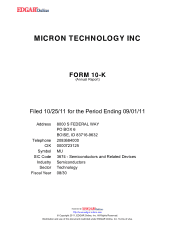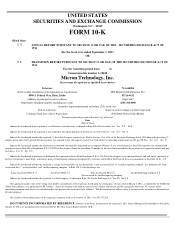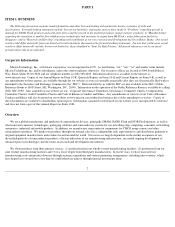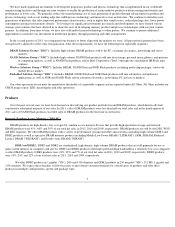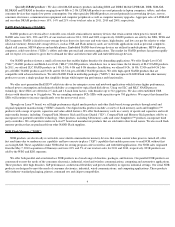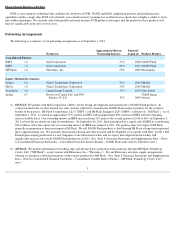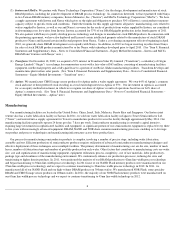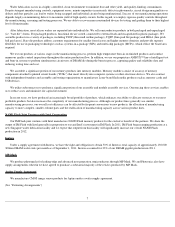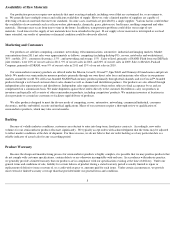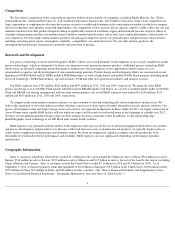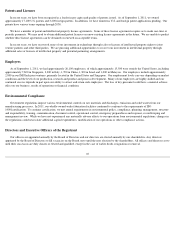Crucial 2011 Annual Report Download - page 8
Download and view the complete annual report
Please find page 8 of the 2011 Crucial annual report below. You can navigate through the pages in the report by either clicking on the pages listed below, or by using the keyword search tool below to find specific information within the annual report.
Wafer fabrication occurs in a highly controlled, clean environment to minimize dust and other yield- and quality-limiting contaminants.
Despite stringent manufacturing controls, equipment errors, minute impurities in materials, defects in photomasks, circuit design marginalities or
defects and dust particles can lead to wafers being scrapped and individual circuits being nonfunctional. Success of our manufacturing operations
depends largely on minimizing defects to maximize yield of high-quality circuits. In this regard, we employ rigorous quality controls throughout
the manufacturing, screening and testing processes. We are able to recover many nonstandard devices by testing and grading them to their highest
level of functionality.
After fabrication, most silicon wafers are separated into individual die. We sell semiconductor products in both packaged and unpackaged
(i.e. "bare die") forms. For packaged products, functional die are sorted, connected to external leads and encapsulated in plastic packages. We
assemble products in a variety of packages, including TSOP (thin small outline package), TQFP (thin quad flat package) and FBGA (fine pitch
ball grid array). Bare die products address customer requirements for smaller form factors and higher memory densities and provide superior
flexibility for use in packaging technologies such as systems-in-a-package (SIPs) and multi-chip packages (MCPs), which reduce the board area
required.
We test our products at various stages in the manufacturing process, perform high temperature burn-in on finished products and conduct
numerous quality control inspections throughout the entire production flow. In addition, we use our proprietary AMBYX™ line of intelligent test
and burn-in systems to perform simultaneous circuit tests of DRAM die during the burn-in process, capturing quality and reliability data and
reducing testing time and cost.
We assemble a significant portion of our memory products into memory modules. Memory modules consist of an array of memory
components attached to printed circuit boards ("PCBs") that insert directly into computer systems or other electronic devices. We also contract
with independent foundries and assembly and testing organizations to manufacture Lexar-brand flash media products such as memory cards and
USB devices.
We utilize subcontractors to perform a significant portion of our assembly and module assembly services. Outsourcing these services enables
us to reduce costs and minimize our capital investment.
In recent years, we have produced an increasingly broad portfolio of products, which enhances our ability to allocate resources to our most
profitable products but also increases the complexity of our manufacturing process. Although our product lines generally use similar
manufacturing processes, our overall cost efficiency can be affected by frequent conversions to new products, the allocation of manufacturing
capacity to more complex, smaller-volume parts and the reallocation of manufacturing capacity across various product lines.
NAND Flash Joint Ventures with Intel Corporation
Our IM Flash joint ventures with Intel manufacture NAND Flash memory products for the exclusive benefit of the partners. We share the
output of IM Flash with Intel generally in proportion to our and Intel's investment in IM Flash. In 2011, IM Flash began ramping production at a
new Singapore wafer fabrication facility and we expect that output from this facility will significantly increase our overall NAND Flash
production in 2012.
Inotera
Under a supply agreement with Inotera, we have the right and obligation to obtain 50% of Inotera's total capacity of approximately 130,000
300mm DRAM wafer starts per month as of September 1, 2011. Inotera accounted for 33% of our DRAM gigabit production in 2011.
MP Mask
We produce photomasks for leading-edge and advanced next generation semiconductors through MP Mask. We and Photronics also have
supply arrangements wherein we have agreed to purchase a substantial majority of the reticles produced by MP Mask.
Aptina Supply Agreement
We manufacture CMOS image sensor products for Aptina under a wafer supply agreement.
(See "Partnering Arrangements")
7

